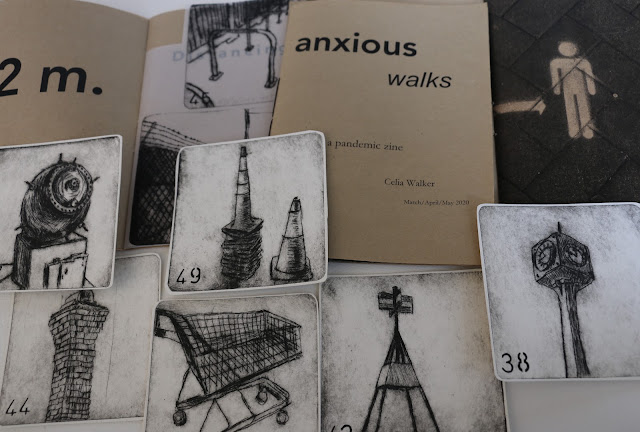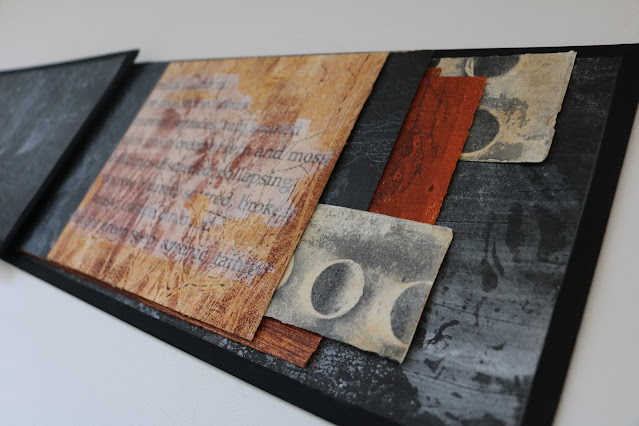Shelter in Place by Celia Walker
Shelter in Place in the Angela Morton Room at Takapuna library brings together a group of artist books by Auckland printmaker Celia Walker. Landscape, environment and cultural history feature in the exhibition, reflecting the artist’s interest in the complex layers that comprise the urban landscape.
A researcher with a background in archives and histories of landscape, including an art history PhD, Celia can’t help but be influenced by heritage. She is interested in the way each place carries with it stories of our cultural landscape through oral, archaeological and documentary records.
The exhibition also has a cartographic thread – the unfolding and layering possibilities of book structures hint at the passage of time or the movement through space. Although there is an aesthetic appeal in the depiction of underlying structures and forms in maps like Hochstetter’s ‘The isthmus of Auckland with its extinct volcanoes’, these slip over cultural history, detaching the landscape from lived sense of place. Celia sees some of her work as a more personal form of mapping, a designation of objects and place markers that are more like a traveller’s map of places visited. The inclusion of historical snippets such as text fragments and vintage postcards helps establish this sense of a continuum with the past.
 |
| Image: Celia Walker, zines and drypoint prints created during the lockdown in March – May 2020. |
In March 2020 her work became much more focused on the present, as the Covid situation escalated she started compiling notes about overheard conversations. Instead of just going about their daily business, people were stopping on street corners and discussing developments – mentioning previously unknown concepts like social distancing, home isolation and border restrictions. The Anxious Walks and Necessary Distance zines were a way of documenting her observations over this period in time.
 |
| Image: Celia Walker, Footfall, solar plate and digital prints, 2019. |
Entering into the first lockdown in March 2020 Celia needed a focus and purpose for those strange days. She began making a series of tiny prints based on each daily exercise walk in her local area, which resulted in 49 Walks. The individual prints were a way of paying attention to small details – away from the bigger stresses of the Covid situation. With so many people out walking, she often took to quiet suburban streets rather than Devonport’s more iconic places, in an effort to keep her distance from others. This led to images of ordinary street objects – letterboxes, fenceposts, railings – anything that caught her eye, all with a sense of age and history. The resulting assemblage of prints captures some sense of Devonport’s older built heritage and layered past – with items from the Navy base and the ferry wharves sitting amongst images of the artfully dilapidated cemetery, early twentieth century brick chimneys and waterfront ironwork.
 |
| Image: Celia Walker, Ground Truth and Rough Ground (detail) linocut and monotype prints, 2018. |
Earlier books made from walks taken overseas reflect this same interest in capturing a sense of urban places, and recording markers of the landscape that reflect the passage through it. The artist’s book Footfall unfolds like a game or puzzle, with interconnected images that can be viewed in multiple ways. The form takes on a sense of walking through a jumble of streets and alleys, and the diverse routes that can be taken through city streets. Although the realities of Covid have shifted Celia’s focus closer to home, these works all have a common thread of interest in place defined by walking.
Other books in the exhibition look more directly at our relationship with the natural world. Diverse and rare natural ecosystems are scattered throughout Auckland, including the shell banks and tidal estuary of Ngataringa Bay, remnants of swamp forest in Smith’s Bush, and the wetland sanctuary of the Tāhuna Tōrea nature reserve. The declining state of Auckland’s natural environment has been noted since early on in the history of European settlement. John Bidwill observed in 1841 that that in the vicinity of the Waitematā harbour even wood for fuel is scarce, and ‘the soil is bad and very swampy’ (Rambles in New Zealand, p. 89). Two decades later the situation had worsened further. In 1959 von Hochstetter wrote a long lament for the disappearing kauri forest, after a walk up the Devonport Peninsula and into Takapuna. He described the transformation into ‘now sterile fern-heaths’ where ‘fragments of upturned wood-giants half decayed, half changed into lignite, which are found here and there buried beneath mounds of earth, are the only remnants of the former forest. Ecological reports and the analysis of ancient pollen samples suggest ways the region’s ecology has been transformed, the tiny fragments of coastal forest and scraps of estuarine vegetation that remain giving only a taste of what was once present. Celia’s small book Plant me a Forest is a hopeful work about forest restoration that looks to a more enlightened future. She uses locally sourced native plant material to create the monotype prints, a method that she often employs as a way of engaging directly with place. The plants were collected from sites where she has been involved with ecological restoration in Devonport and Northland.
 |
| Image: Celia Walker, Plant me a Forest, monotype and etching, 2015. |
Other works hint at the darker side of landscape heritage, where pollution and degradation have left more than just picturesque remains. These ideas are developed in her artworks that look at landscapes of industry: Auckland’s container port and the Waitematā harbour; and those associated with coal mining. Her interest in mining landscapes comes both from climate concerns and from childhood experience. Her father was a mining engineer, and she remembers tagging along on his work trips to open cast coalmines in the northern Waikato. The mining landscapes around the Whangamarino wetland in the northern Waikato and the Denniston Plateau on the West Coast of the south island juxtapose unique and fragile natural ecosystems with harsh and damaging infrastructure. With much of this mining now in decline, what is left contains both visually appealing ruins and a tainted natural environment.
 |
| Image: Celia Walker, Taint, monotype prints and text in bound book, 2022. |
Shelter in Place is open daily in the Angela Morton Room at Takapuna Library, from the 13 August - 29 of September. Please join us on Saturday, 13 August, between 2-4pm, when Celia will be on-site to discuss the work in this exhibition.
Celia Walker has a PhD in art history from the University of Auckland, with a thesis about the travels and landscapes of Charles Heaphy. Diplomas in museum studies and environmental science have led to work in both these areas. Her prints have been selected for several national exhibitions and awards, and international shared print portfolios, and she has exhibited extensively around Aotearoa and overseas.
References
Ferdinand von Hochstetter, The isthmus of Auckland with its extinct volcanoes by Dr Ferdinand von Hochstetter, in Geological and topographical atlas of New Zealand, 1859. Auckland Libraries Heritage Collections, Map 5694b.
Bidwill, J.C., Rambles in New Zealand, London, 1841, (Capper Reprint Series, 1971), p. 89.
Von Hochstetter, F., New Zealand: Its Physical Geography, Geology and Natural History with Special Reference to the Results of Government Expeditions in the Provinces of Auckland and Nelson, Stuttgart, 1867, pp. 251 – 255.

Comments
Post a Comment
Kia ora! Please leave your comment below.